Modern Stonemasonry
Contents |
[edit] CNC engineering and water jet cutting
The craft of stonemasonry has been around for millennia and natural stone is still quarried and fashioned into blocks or slabs in much the same sequence of events as before.
What has changed dramatically is the machinery used to fashion the stone. Hand skills such as polishing and carving are still used to finish the work where appropriate but now the bulk of the process is accomplished by machine.
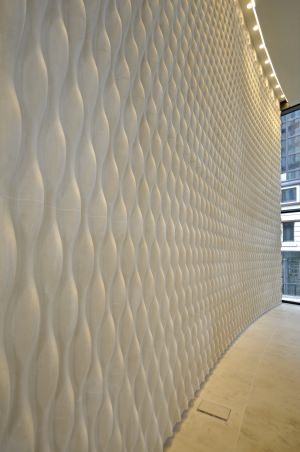
Machined Portland Stone feature wall at Two New Ludgate
[edit] 3D rendering
Architectural models or scans of existing objects can be used to generate surface files that are then sent to a CNC-equipped cutting machine, such as the 5-axis machine installed by stoneCIRCLE which can be used to rough out and saw blocks, as well as shape, contour, engrave and polish them. This is very useful for the production of large monuments or replicating architectural details for restoration projects. The articles can then be finished by hand if necessary.

A 3D rendering of a column capital used to generate surface files
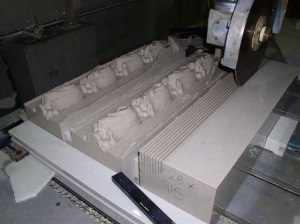
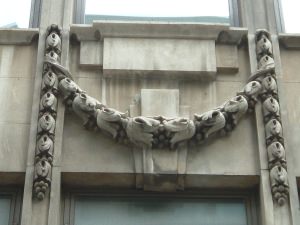
Machining Portland Stone swags for a restoration project and the finished swags in situ at 159 Fenchurch Street.
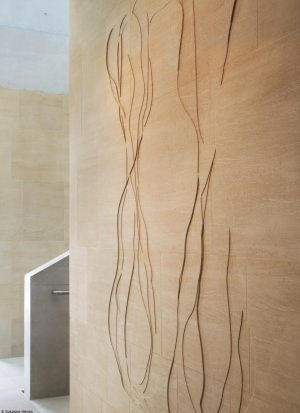
Susanna Heron's Jaumont Yellow Limestone frieze, Henslow's Walk
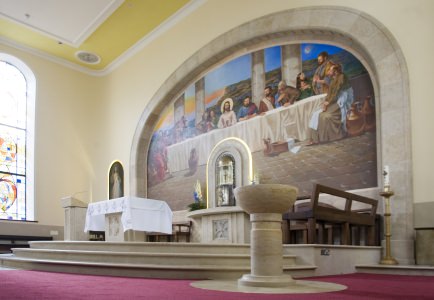
The limestone arch, altar, lectern, font and tabernacle were all produced using CNC-equipped cutting machines.
[edit] Water-jet cutting
Water-jet cutting allows intricate patterns to be cut into stone to create inlaid work for surfaces such as walls and floors and for pierced lattices and grills. It can also be used more creatively as is shown in artworks by Rhona Smith and Julian Opie where bronze is cut on the waterjet cutting machine before being patinated and then inserted into routed Portland Stone.

Tom Phillip's depiction of Tyburn Gallows in Westminster Cathedral is an example of waterjet cutting using several different marbles.
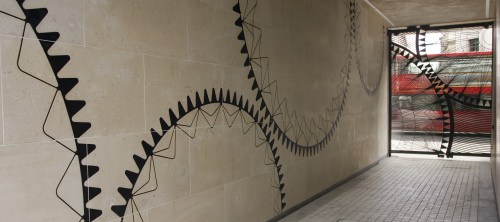
An Age, An Instant by Rhona Smith features waterjet cut bronze set in Portland Stone
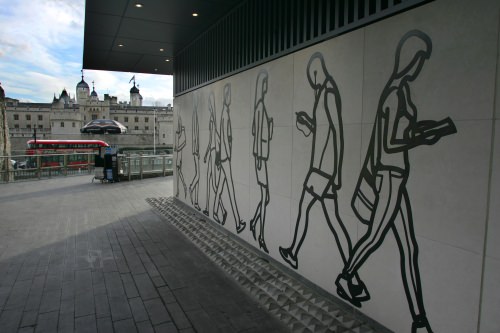
Julian Opie's art installations for CitizenM Hotel, Tower of London and the Hamilton Princess Bermuda use the same technique.
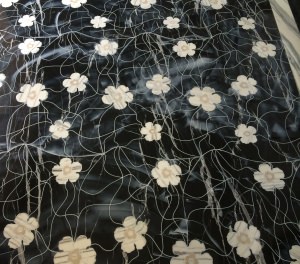
This intricate floor was produced using marble cut on the waterjet cutter and then inlaid into a Nero Marquina marble base.
[edit] Stone: still relevant
As the case studies above show, natural stone is still a relevant material that can be used to create award-winning new architecture. The use of modern technology renders the process much less expensive and time-consuming than it once was and this is made easier still by the use of a stonemason based in the UK with all the advantages of language and proximity that that conveys.
--Stonecircle 11:36, 11 Sep 2018 (BST)
[edit] Related articles on Designing Buildings Wiki
- Building with structural stone.
- Types of stone.
- Choosing stone.
- Kentish ragstone.
- Limestone for building.
- Masonry.
- Iraq, Afghanistan, Gulf War Memorial
- Julian Opie Art Wall CitizenM Tower of London Hotel
- Two New Ludgate Portland Stone Feature Wall
- Use of Stone in Monks Lantern Weybridge
- Bookmatched Marble for Boutique Hotel
- Portland Stone.
- Sustainable stone.
- Julian Opie Limestone & Bronze Frieze for Bermuda Hotel
- Voussoir.
Featured articles and news
International Electrician Day, 10 June 2025
Celebrating the role of electrical engineers from André-Marie Amperè, today and for the future.
New guide for clients launched at Houses of Parliament
'There has never been a more important time for clients to step up and ...ask the right questions'
The impact of recycled slate tiles
Innovation across the decades.
EPC changes for existing buildings
Changes and their context as the new RdSAP methodology comes into use from 15 June.
Skills England publishes Sector skills needs assessments
Priority areas relating to the built environment highlighted and described in brief.
BSRIA HVAC Market Watch - May 2025 Edition
Heat Pump Market Outlook: Policy, Performance & Refrigerant Trends for 2025–2028.
Committing to EDI in construction with CIOB
Built Environment professional bodies deepen commitment to EDI with two new signatories: CIAT and CICES.
Government Grenfell progress report at a glance
Line by line recomendation overview, with links to more details.
An engaging and lively review of his professional life.
Sustainable heating for listed buildings
A problem that needs to be approached intelligently.
50th Golden anniversary ECA Edmundson apprentice award
Deadline for entries has been extended to Friday 27 June, so don't miss out!
CIAT at the London Festival of Architecture
Designing for Everyone: Breaking Barriers in Inclusive Architecture.
Mixed reactions to apprenticeship and skills reform 2025
A 'welcome shift' for some and a 'backwards step' for others.
Licensing construction in the UK
As the latest report and proposal to licence builders reaches Parliament.
Building Safety Alliance golden thread guidance
Extensive excel checklist of information with guidance document freely accessible.
Fair Payment Code and other payment initiatives
For fair and late payments, need to work together to add value.
Pre-planning delivery programmes and delay penalties
Proposed for housebuilders in government reform: Speeding Up Build Out.
High street health: converting a building for healthcare uses
The benefits of health centres acting as new anchor sites in the high street.
























